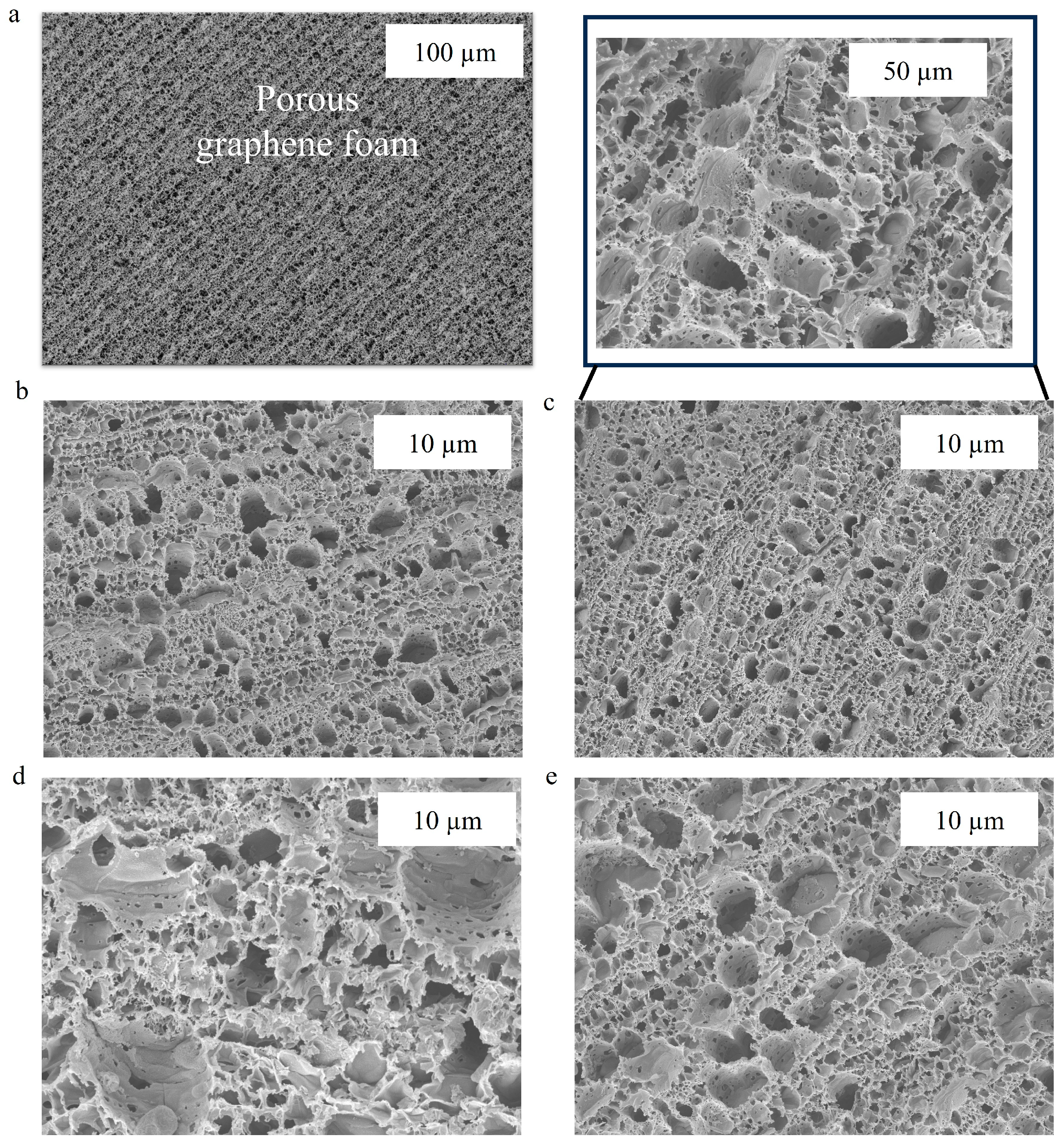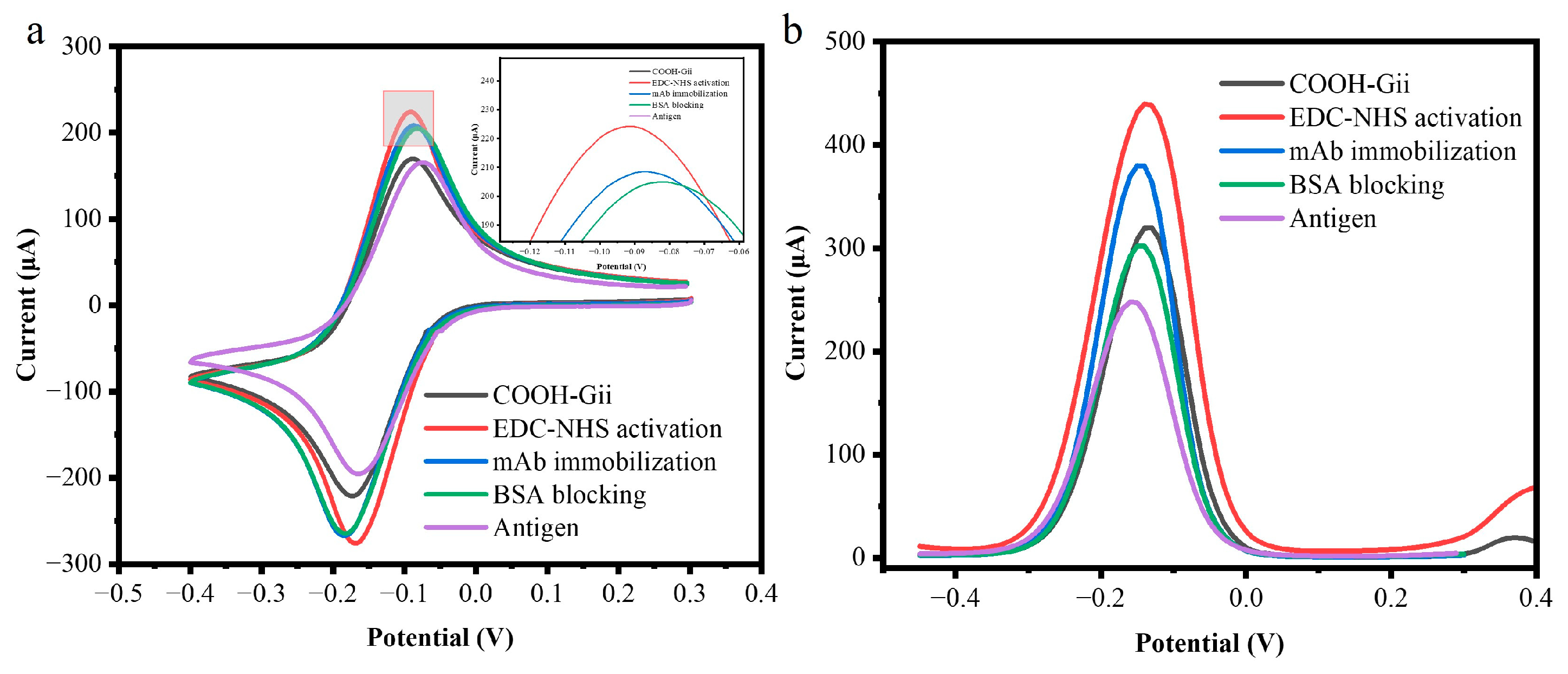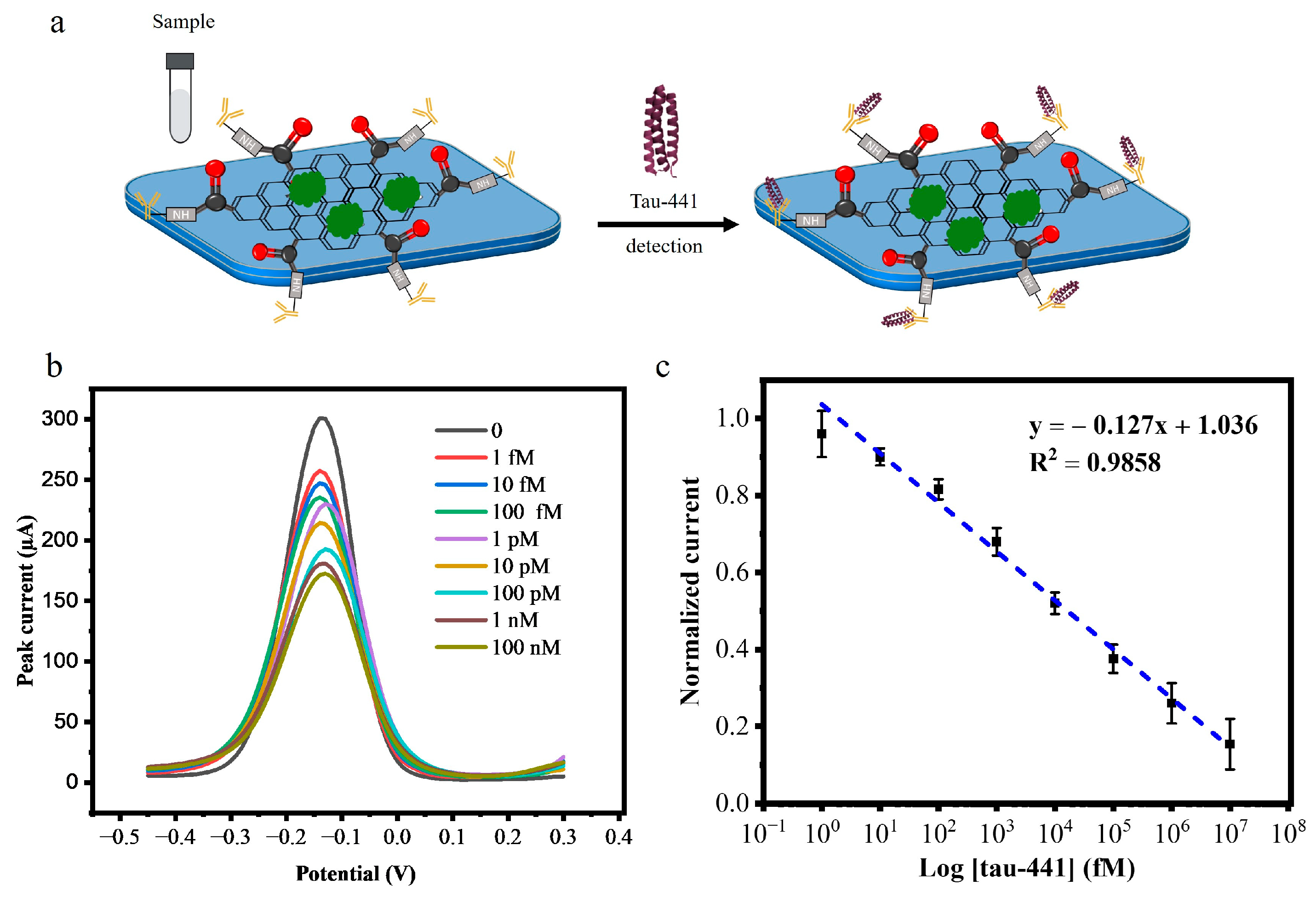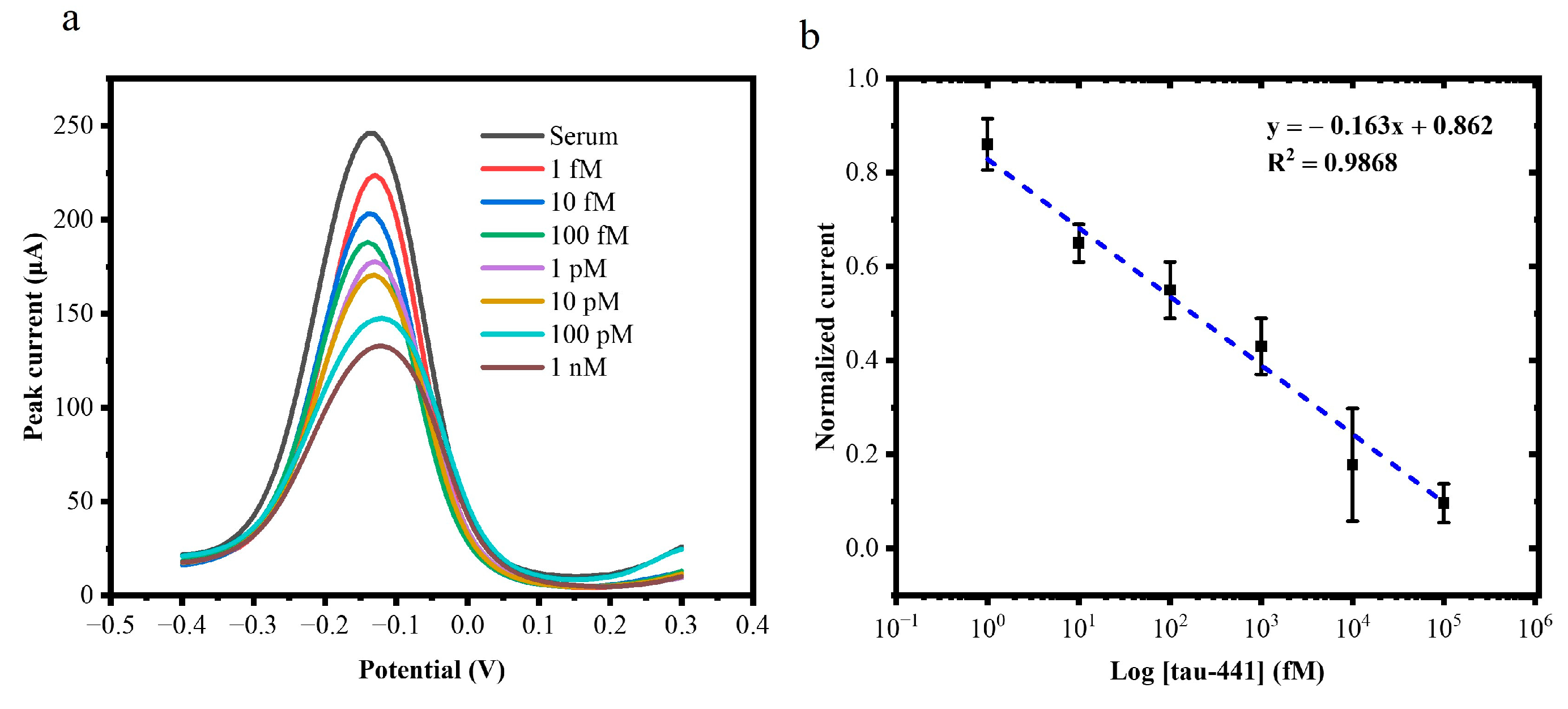Electrochemical Immunosensor Using COOH-Functionalized 3D Graphene Electrodes for Sensitive Detection of Tau-441 Protein
Abstract
1. Introduction
2. Materials and Methods
2.1. Chemicals
2.2. Instruments and Characterization
2.3. Preparation of the Tau Biosensor
2.4. Electrochemical Measurements
2.5. Determination of Tau-441
3. Results
3.1. Surface Characterization
3.2. Tau Biosensor Construction
3.3. Characterization of the Working Electrodes
3.4. Optimization of the Experimental Conditions
3.5. Analytical Performance of the Tau Biosensor
3.6. Stability and Selectivity of the Tau Biosensor
3.7. Human Serum Analysis
4. Discussion
5. Conclusions
Supplementary Materials
Author Contributions
Funding
Data Availability Statement
Acknowledgments
Conflicts of Interest
References
- Bredesen, D.E. Neurodegeneration in Alzheimer’s disease: Caspases and synaptic element interdependenc. Mol. Neurodegener. 2009, 4, 27. [Google Scholar] [CrossRef] [PubMed]
- Anita Pothen Skaria, P. The Economic and Societal Burden of Alzheimer Disease: Managed Care Considerations. Am. J. Manag. Care 2022, 28, S188–S196. [Google Scholar]
- Gozes, I.; Höglinger, G.; Quinn, J.P.; Hooper, N.M.; Höglund, K. Tau diagnostics and clinical studies. J. Mol. Neurosci. 2017, 63, 123–130. [Google Scholar] [CrossRef] [PubMed][Green Version]
- Rosén, C.; Hansson, O.; Blennow, K.; Zetterberg, H. Fluid biomarkers in Alzheimer’s disease—Current concepts. Mol. Neurodegener. 2013, 8, 20. [Google Scholar] [CrossRef] [PubMed]
- P’erez-Ruiz, E.; Decrop, D.; Ven, K.; Tripodi, L.; Leirs, K.; Rosseels, J.; van de Wouwer, M.; Geukens, N.; De Vos, A.; Vanmechelen, E. Digital ELISA for the quantification of attomolar concentrations of Alzheimer’s disease biomarker protein Tau in biological samples. Anal. Chim. Acta 2018, 1015, 74–81. [Google Scholar] [CrossRef] [PubMed]
- Stegurov’a, L.; Dráberová, E.; Bartos, A.; Dr’aber, P.; Rípov’a, D.; Dr’aber, P. Gold nanoparticle-based immuno-PCR for detection of tau protein in cerebrospinal fluid. J. Immunol. Methods 2014, 406, 137–142. [Google Scholar] [CrossRef] [PubMed]
- Huang, A.; Zhang, L.; Li, W.; Ma, Z.; Shuo, S.; Yao, T. Controlled fluorescence quenching by antibody-conjugated graphene oxide to measure tau protein. R. Soc. Open Sci. 2018, 5, 171808. [Google Scholar] [CrossRef] [PubMed]
- Kim, S.; Wark, A.W.; Lee, H.J. Fmtomolar detection of tau proteins in undiluted plasma using surface plasmon resonance. Anal. Chem. 2016, 88, 7793–7799. [Google Scholar] [CrossRef] [PubMed]
- Wu, H.; Duan, Y.; Jiang, L.; Cao, X.; Xie, Z.; Quan, Y.; Ren, M.X.; Wu, S.; Zhang, N.; Yang, Z.; et al. Label-Free Analysis of Protein Biomarkers Using Pattern-Optimized Graphene-Nanopyramid SERS for the Rapid Diagnosis of Alzheimer’s Disease. ACS Appl. Nano Mater. 2024, 7, 9167–9175. [Google Scholar] [CrossRef]
- Li, D.; Scarano, S.; Lisi, S.; Palladino, P.; Minunni, M. Real-time tau protein detection by sandwich-based piezoelectric biosensing: Exploring tubulin as a mass enhancer. Sensors 2018, 18, 946. [Google Scholar] [CrossRef] [PubMed]
- Rawat, P.; Sehar, U.; Bisht, J.; Selman, A.; Culberson, J.; Reddy, P.H. Phosphorylated Tau in Alzheimer’s Disease and Other Tauopathies. Int. J. Mol. Sci. 2022, 23, 12841. [Google Scholar] [CrossRef] [PubMed]
- Mehta, P.D.; Patrick, B.A.; Miller, D.L.; Coyle, P.K.; Wisniewski, T. A Sensitive and Cost-Effective Chemiluminescence ELISA for Measurement of Amyloid-β 1-42 Peptide in Human Plasma. J. Alzheimer’s Dis. 2020, 78, 1237–1244. [Google Scholar] [CrossRef] [PubMed]
- Hong, G.; Wang, M.; Lai, J.; Chen, X.; Yang, Y.; Cheng, L.; He, H.; Liu, J.; Lin, Z.; Zhang, J. Electrochemiluminescence biosensor for P-tau217 based on target-induced change of the steric hindrance effect of an antibody-modified electrode. Microchem. J. 2024, 207, 111807. [Google Scholar] [CrossRef]
- Liu, Q.; Ouyang, Y.; Wang, Y.; Zhou, S.; Zhan, Y.; Wang, L. Multianalyte Nanopore Detection of Alzheimer’s Disease Biomarkers: A Label-Free Platform with Improved Sensitivity and Range. Adv. Heal. Mater. 2025, 14, e2405058. [Google Scholar] [CrossRef] [PubMed]
- Luo, C.; Zhu, X.; Zhang, Y.; Wen, Y.; Wan, L.; Qian, Z. Competitive electrochemical immunosensor for trace phosphorylated Tau181 analysis in plasma: Toward point-of-care technologies of Alzheimer’s disease. Talanta 2025, 292, 128009. [Google Scholar] [CrossRef] [PubMed]
- Wang, J.; Lu, X.; He, Y. Electrochemical Technology for the Detection of Tau Proteins as a Biomarker of Alzheimer’s Disease in Blood. Biosensors 2025, 15, 85. [Google Scholar] [CrossRef] [PubMed]
- Arjun, A.M.; Deshpande, S.; Dunlop, T.; Norman, B.; Oliviera, D.; Vulpe, G.; Moreira, F.; Sharma, S. Alzheimer’s diagnosis beyond cerebrospinal fluid: Probe-Free Detection of Tau Proteins using MXene based redox systems and molecularly imprinted polymers. Biosens. Bioelectron. X 2024, 20, 100513. [Google Scholar] [CrossRef] [PubMed]
- Frias, I.A.M.; Zine, N.; Sigaud, M.; Lozano-Sanchez, P.; Caffio, M.; Errachid, A. Non-covalent π-π functionalized Gii-sense® graphene foam for interleukin 10 impedimetric detection. Biosens. Bioelectron. 2023, 222, 114954. [Google Scholar] [CrossRef] [PubMed]
- Treanor, M.-J.; Lozano-Sanchez, P.; Bunga, Y.; Schaub, R.; Caffio, M. Implementation of a simple functionalisation of graphene (Gii-Sens) in the determination of a suitable linker for use in biocatalytic devices. Appl. Surf. Sci. 2025, 680, 161426. [Google Scholar] [CrossRef]
- Zhang, G.; Shen, Y.; Phipps, J.; Sun, L.; Ma, S. Metal-organic frameworks for the diagnosis and treatment of Alzheimer’s disease: Current status and perspectives. Coord. Chem. Rev. 2024, 518, 216059. [Google Scholar] [CrossRef]
- Yuan, W.; Tao, Q.; Chen, X.; Liu, T.; Wang, J.; Wang, X. Using Machine Learning to Design a FeMOF Bidirectional Regulator for Electrochemiluminescence Sensing of Tau Protein. ACS Appl. Mater. Interfaces 2025, 17, 8924–8936. [Google Scholar] [CrossRef] [PubMed]
- Di Natale, C.; Russo, S.; Graziano, F.; Vespini, V.; Luciani, G.; Vitiello, G.; Lombardi, L.; Ferranti, F.; Mari, S.; Maffettone, P.L.; et al. Sensitive colorimetric immunosensor using AuNP-functionalized polymer film for picogram-level detection of Tau protein intermediate aggregates. J. Colloid Interface Sci. 2025, 678, 1052–1059. [Google Scholar] [CrossRef] [PubMed]
- Chakari-Khiavi, F.; Mirzaie, A.; Khalilzadeh, B.; Yousefi, H.; Abolhasan, R.; Kamrani, A.; Pourakbari, R.; Shahpasand, K.; Yousefi, M.; Rashidi, M.-R. Application of Pt@ZIF-8 nanocomposite-based electrochemical biosensor for sensitive diagnosis of tau protein in Alzheimer’s disease patients. Sci. Rep. 2023, 13, 16163. [Google Scholar] [CrossRef] [PubMed]
- Cancelliere, R.; Di Tinno, A.; Cataldo, A.; Bellucci, S.; Micheli, L. Powerful Electron-Transfer Screen-Printed Platforms as Biosensing Tools: The Case of Uric Acid Biosensor. Biosensors 2021, 12, 2. [Google Scholar] [CrossRef] [PubMed]
- Nazir1, S. Recent Advances and Applications of Graphene-Based Biosensors for Blood-Based Biomarkers in Neurodegenerative Diseases. Biomed. Mater. Devices 2024, 3, 216–236. [Google Scholar] [CrossRef]
- Nazir, S.; Iqbal, R.A. Recent Progress in the Application of Tau Protein Biosensors for Diagnosis of Neurodegenerative Diseases. Appl. Biochem. Biotechnol. 2024, 196, 7476–7502. [Google Scholar] [CrossRef] [PubMed]
- Kulkarni, H.B.; Tambe, P.; Joshi, G.M. Influence of covalent and non-covalent modification of graphene on the mechanical, thermal and electrical properties of epoxy/graphene nanocomposites: A review. Compos. Interfaces. 2018, 25, 381–414. [Google Scholar] [CrossRef]
- Esteves-Villanueva, J.O.; Trzeciakiewicz, H.; Martic, S. A protein-based electrochemical biosensor for detection of tau protein, a neurodegenerative disease biomarker. Analyst 2014, 139, 2823–2831. [Google Scholar] [CrossRef] [PubMed]
- Valenga, M.G.P.; Martins, G.; Martins, T.A.; Didek, L.K.; Gevaerd, A.; Marcolino-Junior, L.H.; Bergamini, M.F. Biochar: An environmentally friendly platform for construction of a SARS-CoV-2 electrochemical immunosensor. Sci. Total Environ. 2023, 858, 159797. [Google Scholar] [CrossRef] [PubMed]
- Cancelliere, R.; Di Tinno, A.; Di Lellis, A.M.; Contini, G.; Micheli, L.; Signori, E. Cost-effective and disposable label-free voltammetric immunosensor for sensitive detection of interleukin-6. Biosens. Bioelectron. 2022, 213, 114467. [Google Scholar] [CrossRef] [PubMed]
- Mokhtar, M.A.M.; Abdul-Aziz, A.; Zaidel, D.N.A.; Ali, R.R. Biochar-Based Materials as Electrochemical Sensors in Food Safety Analysis: A Short Review. J. Phys. Conf. Ser. 2020, 3003, 012027. [Google Scholar] [CrossRef]
- Mowbray, S.E.; Amiri, A.M. A Brief Overview of Medical Fiber Optic Biosensors and Techniques in the Modification for Enhanced Sensing Ability. Diagnostics 2019, 9, 23. [Google Scholar] [CrossRef] [PubMed]
- Li, Y.; Xu, R.; Wang, H.; Xu, W.; Tian, L.; Huang, J.; Liang, C.; Zhang, Y. Recent Advances of Biochar-Based Electrochemical Sensors and Biosensors. Biosensors 2022, 12, 377. [Google Scholar] [CrossRef]
- Sharma, A.; Wulff, A.; Thomas, A.; Sonkusale, S. Ultrasensitive electrochemical sensor for detection of salivary cortisol in stress conditions. Microchim. Acta. 2024, 191, 103. [Google Scholar] [CrossRef] [PubMed]
- Liu, Y.; Liu, X.; Li, M.; Liu, Q.; Xu, T. Portable Vertical Graphene@Au-Based Electrochemical Aptasensing Platform for Point-of-Care Testing of Tau Protein in the Blood. Biosensors 2022, 12, 564. [Google Scholar] [CrossRef] [PubMed]
- Asiaei, S.; Smith, B.; Nieva, P. Enhancing conjugation rate of antibodies to carboxylates: Numerical modeling of conjugation kinetics in microfluidic channels and characterization of chemical over-exposure in conventional protocols by quartz crystal microbalance. Biomicrofluidics 2015, 9, 064115. [Google Scholar] [CrossRef]
- Sharma, A.; Istamboulie, G.; Hayat, A.; Catanante, G.; Bhand, S.; Marty, J.L. Disposable and portable aptamer functionalized impedimetric sensor for detection of kanamycin residue in milk sample. Sens. Actuators B Chem. 2017, 245, 507–515. [Google Scholar] [CrossRef]
- Mishyn, V.; Hugo, A.; Rodrigues, T.; Aspermair, P.; Happy, H.; Marques, L.; Hurot, C.; Othmen, R.; Bouchiat, V.; Boukherroub, R.; et al. The holy grail of pyrene-based surface ligands on the sensitivity of graphene-based field effect transistors. Sens. Diagn. 2022, 1, 235–244. [Google Scholar] [CrossRef]
- Naoki, M.; Takuya, K.; Yuta, N. Tailoring the oxygen content of graphite and reduced graphene oxide for specific applications. Scietific Rep. 2016, 6, 21715. [Google Scholar]
- Ben Hassine, A.; Raouafi, N.; Moreira, F.T. Novel biomimetic Prussian blue nanocubes-based biosensor for Tau-441 protein detection. J. Pharm. Biomed. Anal. 2023, 226, 115251. [Google Scholar] [CrossRef] [PubMed]
- Shui, B.; Tao, D.; Cheng, J.; Mei, Y.; Jaffrezic-Renault, N.; Guo, Z. A novel electrochemical aptamer–antibody sandwich assay for the detection of tau-381 in human serum. Analyst 2018, 143, 3549–3554. [Google Scholar] [CrossRef] [PubMed]
- Tao, D.; Shui, B.; Gu, Y.; Cheng, J.; Zhang, W.; Jaffrezic-Renault, N.; Song, S.; Guo, Z. Development of a Label-Free Electrochemical Aptasensor for the Detection of Tau381 and Its Preliminary Application in AD and Non-AD Patients’ Sera. Biosensors 2019, 9, 84. [Google Scholar] [CrossRef] [PubMed]
- Shiravandi, A.; Yari, F.; Tofigh, N.; Kazemi Ashtiani, M.; Shahpasand, K.; Ghanian, M.H.; Shekari, F.; Faridbod, F. Earlier Detection of Alzheimer’s Disease Based on a Novel Biomarker cis P-tau by a Label-Free Electrochemical Immunosenso. Biosensors 2022, 12, 879. [Google Scholar] [CrossRef]
- Ye, M.; Jiang, M.; Cheng, J.; Li, X.; Liu, Z.; Zhang, W.; Mugo, S.M.; Jaffrezic-Renault, N.; Guo, Z. Single-layer exfoliated reduced graphene oxide-antibody Tau sensor for detection in human serum. Sens. Actuators B Chem. 2020, 308, 127692. [Google Scholar] [CrossRef]
- Sethi, J.; Van Bulck, M.; Suhail, A.; Safarzadeh, M.; Perez-Castillo, A.; Pan, G. A label-free biosensor based on graphene and reduced graphene oxide dual-layer for electrochemical determination of beta-amyloid biomarkers. Microchim. Acta 2020, 187, 288. [Google Scholar] [CrossRef] [PubMed]
- Sethi, J.; Suhail, A.; Safarzadeh, M.; Sattar, A.; Wei, Y.; Pan, G. NH2 linker for femtomolar label-free detection with reduced graphene oxide screen-printed electrodes. Carbon 2021, 179, 514–522. [Google Scholar] [CrossRef]
- Guo, S.; Raya, J.; Ji, D.; Nishina, Y.; Ménard-Moyon, C.; Bianco, A. Is carboxylation an efficient method for graphene oxide functionalization? Nanoscale Adv. 2020, 2, 4085–4092. [Google Scholar] [CrossRef] [PubMed]






| Type of Tau Peptide | Receptor | Method | Electrode Material | Linear Range | Matrix Type | Detection Limit | Ref. |
|---|---|---|---|---|---|---|---|
| tau-441 | Antibody | DPV | GO/PBNCs/C-SPE | 1.09–2.18 pmol/L | PBS | 0.01 pmol/L | [40] |
| tau-441 | PANI-Tau-441 | DPV | Vanadium MXene polydopamine (Vx PDA) | 122 aM/L to 122 pM/L | Interstitial fluid (ISF) and plasma | 60 aM/L | [17] |
| tau-381 | Antibody+aptamer | DPV, CV, and EIS | Gold nanoparticles (AuNPs) | 0.5 pM–100 pM | Human serum | 0.42 pM | [41] |
| tau-181 | Aptamer | DPV, CV, and EIS | Glassy-carbon electrode | 1 pM–100 pM | Human serum | 0.70 pM | [42] |
| cis P-tau | DNAzyme | DPV, CV, and EIS | Gold electrode | 10 × 10−14 M–3.0 × 10−9 M | PBS and serum | 0.02–0.05 pM | [43] |
| tau-441 | Antibody | SWV and CV | Reduced graphene oxide (rGO) | 0.08–80 pM | Human serum | 75 fM | [44] |
| tau-441 | Antibody | DPV | COOH-GF | 1 fM–1 nM | Human serum | 0.14 fM | Present work |
Disclaimer/Publisher’s Note: The statements, opinions and data contained in all publications are solely those of the individual author(s) and contributor(s) and not of MDPI and/or the editor(s). MDPI and/or the editor(s) disclaim responsibility for any injury to people or property resulting from any ideas, methods, instructions or products referred to in the content. |
© 2025 by the authors. Licensee MDPI, Basel, Switzerland. This article is an open access article distributed under the terms and conditions of the Creative Commons Attribution (CC BY) license (https://creativecommons.org/licenses/by/4.0/).
Share and Cite
Nazir, S.; Dogan, M.; Wei, Y.; Pan, G. Electrochemical Immunosensor Using COOH-Functionalized 3D Graphene Electrodes for Sensitive Detection of Tau-441 Protein. Biosensors 2025, 15, 465. https://doi.org/10.3390/bios15070465
Nazir S, Dogan M, Wei Y, Pan G. Electrochemical Immunosensor Using COOH-Functionalized 3D Graphene Electrodes for Sensitive Detection of Tau-441 Protein. Biosensors. 2025; 15(7):465. https://doi.org/10.3390/bios15070465
Chicago/Turabian StyleNazir, Sophia, Muhsin Dogan, Yinghui Wei, and Genhua Pan. 2025. "Electrochemical Immunosensor Using COOH-Functionalized 3D Graphene Electrodes for Sensitive Detection of Tau-441 Protein" Biosensors 15, no. 7: 465. https://doi.org/10.3390/bios15070465
APA StyleNazir, S., Dogan, M., Wei, Y., & Pan, G. (2025). Electrochemical Immunosensor Using COOH-Functionalized 3D Graphene Electrodes for Sensitive Detection of Tau-441 Protein. Biosensors, 15(7), 465. https://doi.org/10.3390/bios15070465





